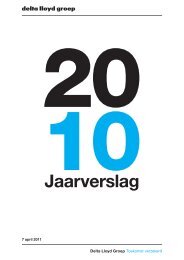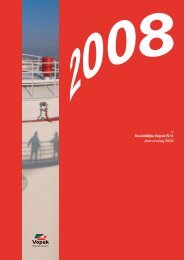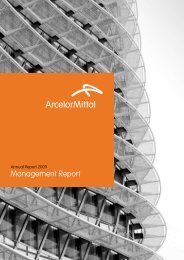2008 Annual Report - SBM Offshore
2008 Annual Report - SBM Offshore
2008 Annual Report - SBM Offshore
- No tags were found...
You also want an ePaper? Increase the reach of your titles
YUMPU automatically turns print PDFs into web optimized ePapers that Google loves.
98 <strong>SBM</strong> <strong>Offshore</strong> <strong>Annual</strong> <strong>Report</strong> <strong>2008</strong> / Financial Statements <strong>2008</strong>Derivative financial instruments and hedging activitiesGeneralThe Company uses derivative financial instruments such as forward currency contracts and interest rate swaps to hedge its risksassociated with foreign currency and interest rate fluctuations. Such financial instruments are initially recognised at fair value on thedate on which a financial contract is entered into and are subsequently remeasured at their fair value. The method of recognising theresulting gain or loss depends on whether the derivative is designated as a hedging instrument, and if so, the nature of the item beinghedged. Financial instruments are presented as assets when the fair value is positive and as liabilities when the fair value is negative.Any gains or losses arising from changes in fair value on financial instruments that do not qualify for hedge accounting are takendirectly to the income statement.The fair value of forward currency contracts is calculated by reference to current forward exchange rates for contracts with similarmaturity profiles using quoted market rates. The fair value of interest rate swap contracts is determined by reference to market ratesfor similar contracts.For hedge accounting, hedges are classified as:• fair value hedges when hedging exposure to changes in fair value of a recognised asset or liability or a firm commitment (fair valuehedge);• cash flow hedges when hedging the exposure to variability in cash flows that is either attributable to a particular risk associated witha recognised asset or liability or a highly probable forecasted transaction (cash flow hedge);• hedges of net investments in a foreign operation (net investment hedge).At the inception of a hedge relationship, the Company formally designates and documents the hedge relationship to which theCompany wishes to apply hedge accounting and the risk management objective and strategy for undertaking the hedge. Thedocumentation includes identification of the hedging instruments, the hedged item, or transaction, the nature of the risk being hedgedand how the Company will assess the hedging instrument’s effectiveness in offsetting exposure to changes in the fair value of thehedged item or cash flows attributable to the hedged risk. Such hedges are expected to be highly effective in offsetting changes in thefair value of the hedged item or cash flows and are assessed periodically to determine that they actually have been highly effectivethroughout the financial reporting periods for which they were designated. The Company uses cash flow hedges and hedges of netinvestments in a foreign operation.Hedges which meet the strict criteria for hedge accounting are accounted for as follows: The effective portion of the gain or loss on thehedging instrument is recognised directly in equity, while the ineffective portion is recognised in the income statement. Amounts takento equity are added or deducted from the recognised value of the hedged item upon its recognition and to the income statement whenthe hedged transaction affects the income statement. When a hedging instrument expires or is sold, or when a hedge no longer meetsthe criteria for hedge accounting, any cumulative gain or loss existing in equity at that time remains in equity and is recognised whenthe forecasted transaction is ultimately recognised in the income statement.If the forecasted transaction is no longer expected to occur, amounts previously recognised in equity are transferred to the incomestatement.The fair values of various derivative financial instruments used for hedging purposes are disclosed in note 18 of the financialstatements. Movements in the hedging reserve in equity attributable to shareholders are shown in note 20 of the financial statements.LeasingA lease is an agreement whereby the lessor conveys to the lessee in return for a payment, or series of payments, the right to use anasset for an agreed period of time. Leases in which a significant portion of the risk and rewards of ownership are retained by the lessorare classified as operating leases.When assets are leased out under a finance lease, the present value of the lease payments is recognised as a receivable. The differencebetween the gross receivable and the present value of the receivable is recognised as unearned finance income.Lease income is, as of the commencement date of the lease contract, recognised over the term of the lease using the net investmentmethod, which reflects a constant periodic rate of return. During the construction period of the facility, the contract is treated as aconstruction contract, whereby the stage of completion method is applied.When assets are leased out under an operating lease, the asset is included in the balance sheet based on the nature of the asset.Lease income is recognised over the term of the lease on a straight line basis.
















